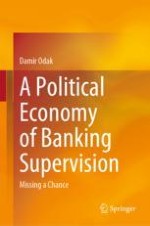2020 | OriginalPaper | Buchkapitel
13. What Now?
verfasst von : Damir Odak
Erschienen in: A Political Economy of Banking Supervision
Aktivieren Sie unsere intelligente Suche, um passende Fachinhalte oder Patente zu finden.
Wählen Sie Textabschnitte aus um mit Künstlicher Intelligenz passenden Patente zu finden. powered by
Markieren Sie Textabschnitte, um KI-gestützt weitere passende Inhalte zu finden. powered by
